New Hampshire
The origins of New Hampshire lie in a fishing colony established in 1623 under a land grant given to Captain John Mason. He sent Scotsman David Thomson and a number of other people to establish the colony at the mouth of the Piscataqua River. Mason named the colony New Hampshire after his home county of Hampshire but never set foot in it. The town of Portsmouth on the Piscataqua estuary was named in 1653 after Mason’s home town in England. New Hampshire took early action in the build up to the Revolutionary War, ratifying its own state constitution as on January 5, 1776 and establishing its own independent government, the first colony to do this. Becaues the New Hamshire constitution stated that they ‘never sought to throw off our dependence on Great Britain’ it is Rhode Island that is credited with the first full declaration of independence. New Hampshire was 6 months ahead of the formal US declaration of independence, but only the 9th state to ratify the US Constitution, a little slow by their previous standards. New Hampshire has only a short coastline sandwiched between Massachusetts and Maine, but it has a history of shipbuilding and commerce. Inland the tradition is of agriculture but the state is best known for its mountains and as a result it is nicknamed the Granite state. The inland area is heavily forested, so New Hampshire is a great place to visit in the autumn to view the fall foliage.
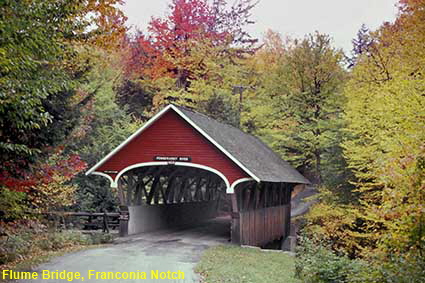
Fall foliage near Chocorua
Way back in 1985 we made our first trip to New England with the aim of seeing the fall foliage. It was in the White Mountains of New Hampshire that we found the fall foliage at its peak. Sadly the weather did not behave itself, but even in these gloomy conditions the autumnal reds and yellows on the trees are striking.
Flume Bridge, Franconia Notch
Although they can be found in other parts of the USA, covered bridges are a New England speciality and New Hampshire still has more than 50 of them. This bridge spanning the Pemigewasset River dates from 1871 and is relatively short at 15 metres (50 feet) long. It is thought that this may not be the original location of the bridge. The bridge is of Paddleford Truss construction, which is described on the Maine Covered Bridges page.
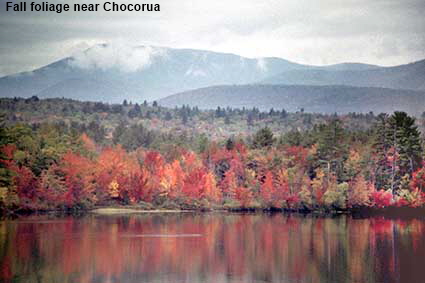
Waterfront at Meredith
On the shore of Lake Winnipesaukee sits the town of Meredith. Founded in 1748 it was originally called Palmer’s Town after the man who laid out much of the land surrounding Lake Winnipesaukee. The name was changed to New Salem, then in 1768 to Meredith after Sir William Meredith, who opposed taxation on the colonies. Now home to around 6,000 people its setting by the lake ensures that it is a tourist destination. The town also has a preserved railroad, the Winnipesaukee Scenic Railroad which provides trips along the shore of the lake to Lakeport. Click Tab 2 to see the Winnipesaukee Scenic Railroad.
Click on Minimap to navigate
Home > US States > New England >
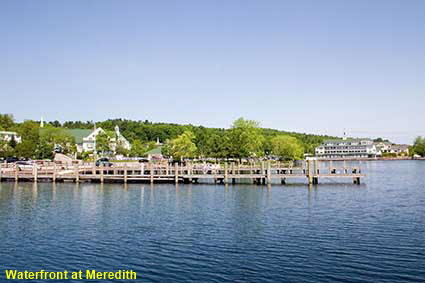
Town Hall & Church, Canterbury
Canterbury is a small town of around 2,000 people best known for the nearby Shaker Village. The classic building in any New England small town is the church with it tall, white spire. In this picture the Canterbury United Community Church is augmented on the left by the 1736 Town Hall building. An idyllic scene, if only we had been there in the autumn for the fall foliage!
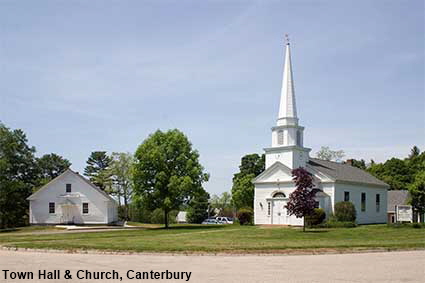
Honeymoon Covered Bridge , Jackson
Our second New Hampshire covered bridge is, like the Flume Bridge, of Paddleford Truss construction. It was built around 1876 by Charles Austin Broughton and his son Frank, while the pedestrian walkway on the left was added in 1930. It has a span of 31.4 metres (103 feet) across the the Ellis River.
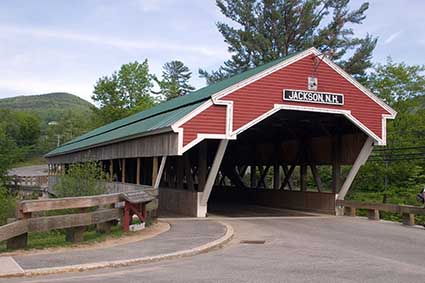
DLU180427


We have more pages on New Hampshire. Click below or on the Minimap:
Castle in the Clouds, Moultonborough
Between 1913 and 1914 shoe millionaire Thomas Plant built his dream home in the Ossipee Mountains looking out over Lake Winnipesaukee. The house was called Lucknow and was the centre of an estate that grew to 2,550 hectares (6,300 acres) in size. Although the house was sold after Plant’s death in 1941, the Arts and Crafts architecture of the house was retained by subsequent owners. Now managed by a non-profit organisation called the Castle Preservation Society the house and grounds are open to the public. Due to its lofty position, the house is now known as ‘Castle in the Clouds’
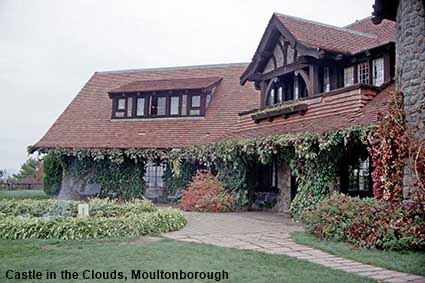
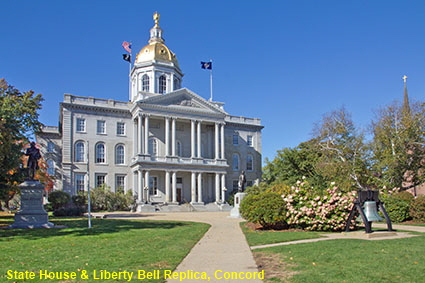
State House & Liberty Bell Replica, Concord
After the Revolutionary War, New Hampshire had no permanent seat of government. Concord, Hopkinton, and Salisbury put themselves forward and in 1808 Concord was selected as the capital. In 1814 lawmakers began discussing the need for a State House and in 1816 plans for a State House in Concord were agreed. When we write about the construction of Capitols the story is often that no expense was spared but the State House in Concord was a paragon of frugality. It was built using granite from quarries in the north of the town and the stones were cut, shaped and faced by local prison inmates. The building was completed in 1819 at a cost of only $82,000. By the 1850s State House was too small and in 1863 the city of Manchester, keen to become capital, offered to build a new Capitol. The legislature voted to stay in Concord and an extension was completed in 1866 at a cost of $200,000. By the beginning of the 20th century State House had again become too small and Manchester tried again to become capital. The result was the same, State House in Concord was extended and modernised and it has not undergone significant change since. It is the oldest State House in which the legislature still sits in its original chambers. An Annex was built in 1938 to provide extra space. There are daily public tours of the State House, but they must be booked in advance.
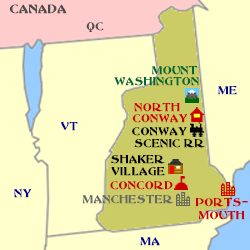

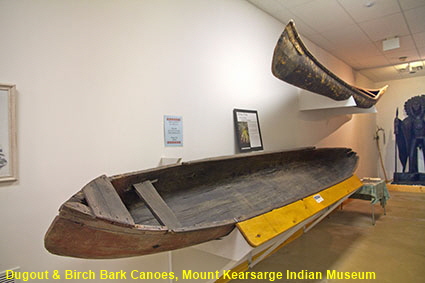
Dugout & Birch Bark Canoes, Mount Kearsarge Indian Museum
We have visited quite a few Indian museums, mainly in the west and most of them run by individual tribes. While we have found fascinating stories of tribal history in these museums, most of them were poorly organised and rarely designed to put their exhibits in the context of the bigger picture. Mount Kearsarge Indian Museum presents a much wider picture probably because of its origins. In 1929 Grand Chief Sachem Silverstar addressed a second grade classroom in Newport, RI and his message left a lasting impression on 7 year old Charles ‘Bud’ Thompson. Bud became an avid collector of Indian artefacts. Over the years his collection grew and grew. In 1990 Bud and his wife Nancy decided to use their artefacts to set up a museum that would also serve as an educational and cultural centre. Their aim was to pass on to new generations Chief Silverstar’s message that everyone has a special power and can individually make a positive difference to create a better world. The collection in the muesum is impressive and it is organised to tell a compelling story. The museum is open daily from May to October. Click Tab 2 to see a buffalo skull beautifully decorated with turquoise.
© Mike Elsden 1981 - 2025
The contents of this page may not be reproduced in full or in part without permission